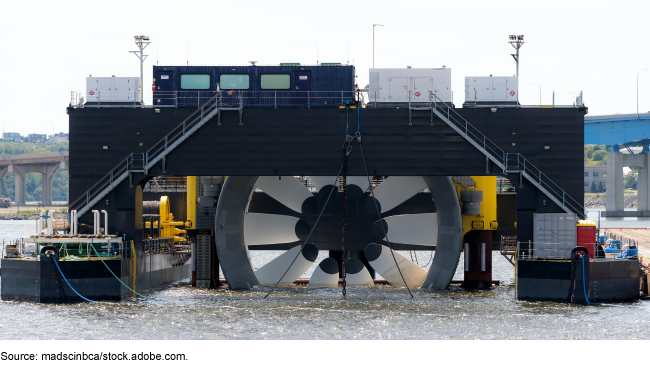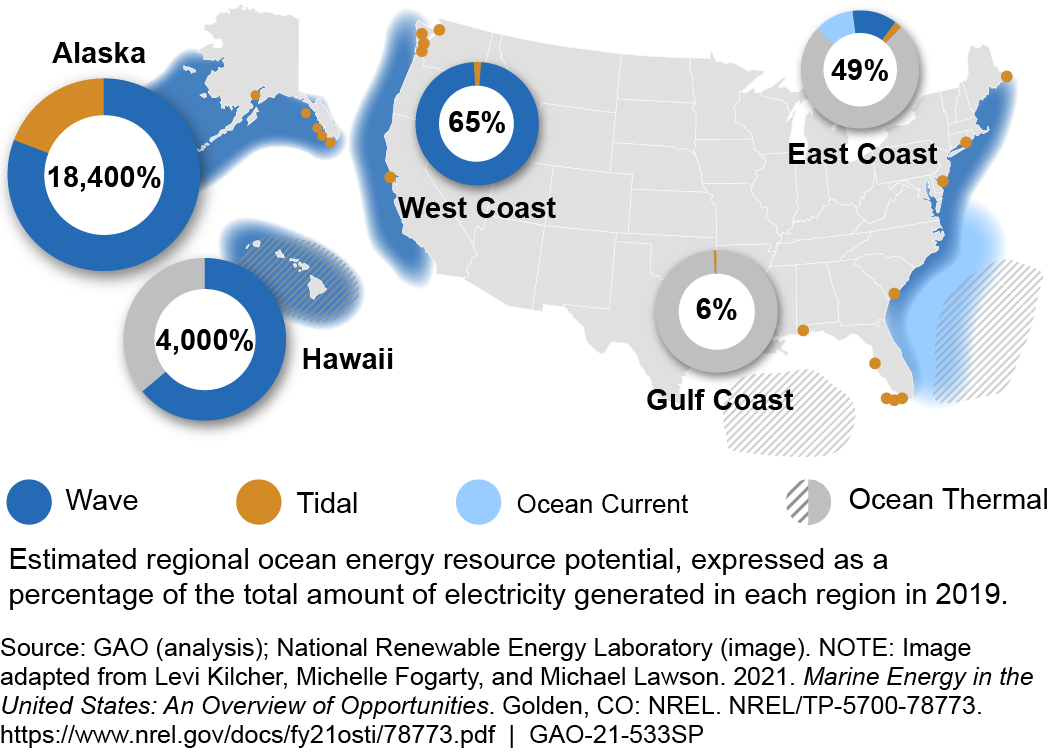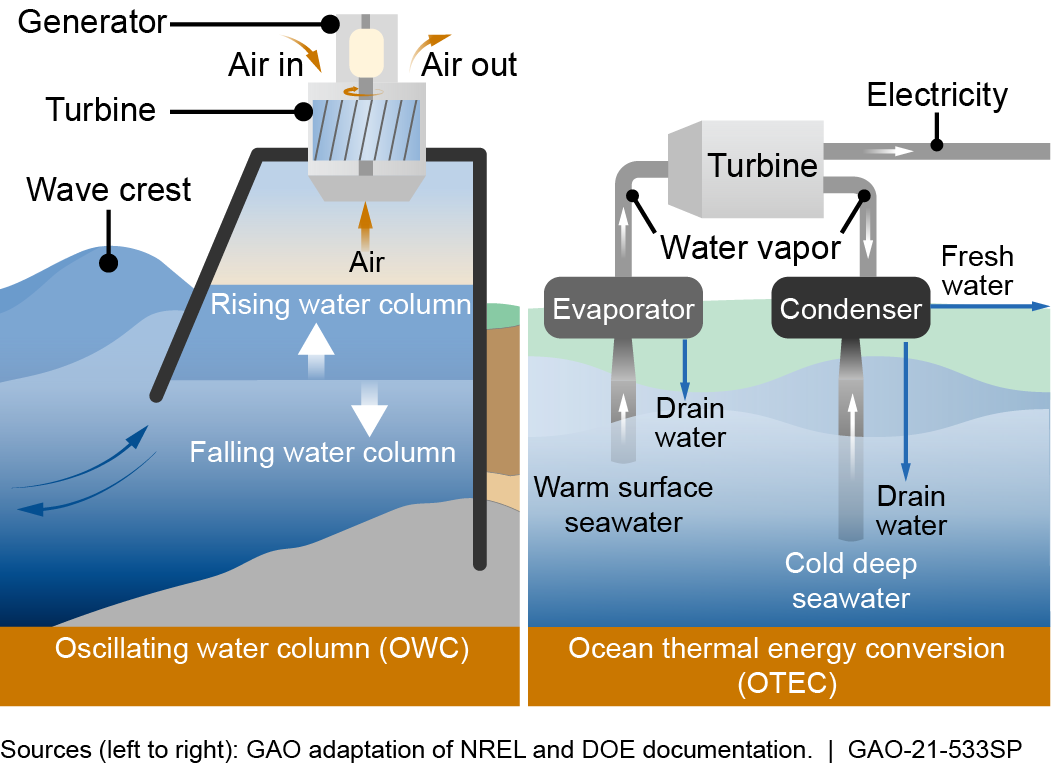Science & Tech Spotlight: Renewable Ocean Energy
Fast Facts
This spotlight explores renewable ocean energy technology.
These technologies include:
Wave energy converters, which generate power from surface waves
Tidal energy converters, which generate power from the movement of tidal currents
Ocean thermal energy converters, which generate power from thermal differences between warm surface seawater and cold deep seawater
Ocean energy could power offshore activities and isolated island and coastal communities. However, these technologies are generally costlier than other renewable energy technologies, so it may be some time before they can be fully deployed.
Note: This Fast Facts has been updated with a new visual.
A system used for harnessing tidal energy.

Highlights
Why This Matters
Renewable ocean energy has the potential to reduce global carbon emissions from fossil fuels by 500 million tons by 2050, and could also meet the energy needs of isolated communities, which may not have access to reliable electricity sources. However, the technologies can be costly and more research is needed to understand their potential effects on marine wildlife.
The Technology
What is it? Renewable ocean energy (or, simply, ocean energy), is energy derived from the ocean's movement, or from its physical and chemical state. In the United States, ocean energy can be generated from waves, tides, and currents, as well as ocean temperature differences. The National Renewable Energy Laboratory estimates that if fully utilized, ocean energy resources in the U.S. could provide the equivalent of over half of the electricity that the country generated in 2019. U.S. government and industry stakeholders predict that ocean energy will likely be first used to provide power for energy and water needs of island and coastal communities and offshore activities. According to these stakeholders, using ocean energy for these activities and communities will help advance the technologies and contribute toward making ocean energy cost-competitive in some additional markets.

Figure 1. The extent to which ocean energy could potentially supplement the existing electricity supply varies across different regions.
How does it work? Ocean energy resources can be harnessed using a variety of devices, depending on the type of energy they harness, the amount of power they need to supply, and other factors. Devices that capture the energy of moving water vary in design and scale, depending on whether they are made to harness waves, tides, or ocean currents.
Wave energy converters use surface waves to generate power. For example, one type of wave energy converter generates power by using wave motion as a piston to drive air in and out of a chamber, with the moving air driving a turbine. Tidal energy converters use the horizontal movement of tidal currents to generate power, typically through submerged turbines whose propellers are spun by the current, analogous to wind turbines. Devices that capture energy from non-tidal ocean currents, such as the Gulf Stream, also use currents to spin a turbine and generate energy. Some technologies, such as tidal kites, can harness both higher velocity tidal currents and lower velocity offshore currents through a special "kite" tethered underwater. The kite uses control flaps to move in a fixed pattern across the current, increasing the speed of water flow across the turbine blades in the kite, thereby extracting more energy.
Ocean thermal energy converter (OTEC) power plants convert the thermal differences between warm surface seawater and cold deep seawater into power and are intended to be deployed as large-scale power plants. OTEC plants use this temperature difference to produce electricity. Specifically, warm surface water is pumped through an evaporator which evaporates a working fluid (which can be the surface water itself). The resulting vapor expands and drives a turbine generator, producing electricity. The vapor is then condensed back into a fluid using cold water pumped from deep in the ocean.

Figure 2. Example of an oscillating water column, which is a type of wave energy converter, and an OTEC power plant.
How mature is it? Wave and tidal energy converters are in the early stages of commercialization. While tidal energy converters have begun to converge toward a single design, wave energy converters have not. This is in part because wave energy converter developers have started to focus on smaller, purpose-designed devices for niche energy markets.
OTEC and ocean current technologies are currently small scale and have had only limited deployments. One of three active OTEC power plants in the world is located in Hawaii; but the stakeholders developing this technology are mainly research institutes and universities rather than industry because of the uncertainty on the return on investment for this technology. Tidal kites could harness ocean current energy. However developers are planning limited commercial deployments to capture energy from tidal currents rather than ocean currents, in part, because ocean currents are further offshore, which complicates deployment.
Opportunities
- Climate change mitigation. According to the International Energy Agency, globally, ocean energy could help mitigate the effects of climate change by reducing carbon emissions from fossil fuel-driven electricity generation by an estimated 500 million tons by 2050.
- Predictable and stable energy. Compared to other renewable energy sources, ocean energy provides more predictable and nearly continuous electrical generation. Ocean energy technologies could support and stabilize electrical grids that integrate other, more intermittent renewable energy sources, such as solar and wind.
- Offshore power. Ocean energy can provide locally sourced and reliable power to offshore industries, activities, and systems such as farming marine organisms, navigation, and deployed ocean sensors, which tend to rely on batteries that limit their range and usefulness.
- Support for coastal and rural island communities. Ocean energy could help meet the water and energy needs of rural coastal and island communities by providing locally sourced power for producing drinking water and reducing reliance on diesel generators, which are costly, emit carbon dioxide, and are vulnerable to supply disruption.
- Disaster Recovery. Ocean energy could aid natural disaster recovery in certain places by providing affected communities with a resilient source of energy. For example, ocean energy devices built in breakwaters could be protected during a disaster and thus able to provide those communities with desalinated water and electricity.
Challenges
- High costs. Ocean energy technologies are generally costlier than other renewable energy technologies because of high installation, operation, and maintenance costs. This reinforces a perception that ocean energy is risky, and makes it harder to find investors and insurance.
- Infrastructure. Ocean energy technologies face significant infrastructure challenges and underdeveloped supply chains. For example, connecting these devices to the electrical grid can be costly and some components will undergo considerable weathering.
- Regulatory challenges. The management of ocean and coastal activities involves multiple federal and state authorities. The resulting regulatory process can be lengthy and expensive.
- Environmental effects. The main environmental risks of ocean energy technologies include collision of marine life with underwater turbines, creation of underwater sound, and habitat changes. More research is needed to assess the long-term effect of ocean energy technologies on the environment and marine wildlife.
Policy Context and Questions
With several ocean energy technologies now powering coastal and island communities, some key questions for policymaker consideration include:
- What steps could policymakers take, such as assessing strategies to reduce deployment costs, to further integrate mature ocean energy technologies into regional electric grids?
- What analyses of incentives and barriers are needed to explore ways of stimulating private sector development of ocean energy infrastructure and supply chains?
- What actions could policymakers take to ensure adequate information is gathered to determine whether ocean energy technologies are ready for integration into disaster preparedness and response plans?
- What steps could policymakers take to ensure that sufficient data and analysis are available concerning the environmental effects of ocean energy technologies?
For more information, contact Karen Howard at (202) 512-6888 or HowardK@gao.gov.
